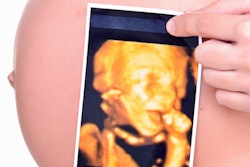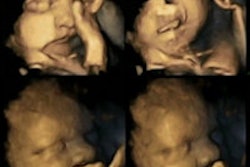A review of 21 years of experience from the Czech Republic's national prenatal ultrasound screening program found significant and improving antenatal detection of congenital heart disease (CHD). But mortality still remains high, according to the research published in Heart.
A study team led by Jan Marek, MD, of University Hospital Motol in Prague, found that the program detected major cardiac abnormalities in one-third of patients born with any congenital heart disease, as well as 80% of those with critical forms. Unfortunately, though, the researchers also found that only one-third of the affected fetuses remained alive at the end of the study period.
Nonetheless, the researchers said the data showed a different disease spectrum in prevalence and outcome and that their findings are crucial for planning future congenital heart disease services in Europe (Heart, January 2011, Vol. 97:2, pp. 124-130).
"Antenatal detection of major congenital cardiac abnormalities may, in some countries, significantly reduce postnatal prevalence of complex CHD," the authors wrote. "Extreme investments in developing [pediatric] cardiac [centers] can then be transferred towards improving and optimizing care of the exponentially increasing numbers of adults with CHD."
To determine the prevalence and spectrum of congenital heart disease and to gauge the effects of a national prenatal ultrasound screening program on patient outcome in a large, representative, and unselected population, the research team evaluated a comprehensive registry of all pediatric and fetal patients with CHD from 1986 to 2006 in the Czech Republic.
In the nationwide prenatal screening program, a local ob/gyn performed prenatal ultrasound screening with echocardiography on every resident pregnant woman between 18 and 21 weeks of gestation. The routine ultrasound scan employed 2D imaging to obtain a four-chamber view and to visualize the cropping of both of the great arteries, according to the researchers.
Available via the country's centralized healthcare system, confirmation of prenatal and postnatal findings were determined clinically and by postmortem examination.
Of the 9,475 fetuses referred for detailed cardiac evaluation during the study period, 1,604 (16.9%) had congenital heart disease. Additional extracardiac abnormalities were present in 501 (31.2%) of these fetuses with CHD.
Of the 685 pregnancies that were continued, 59 (8.6%) died in utero; the rest were born alive. The authors found that the most common lesions were atrioventricular septal defect in (243 cases, 15.1%), hypoplastic left heart syndrome (241 cases, 15%), and double outlet right ventricle (140 cases, 8.7%).
Other diagnoses included pulmonary atresia (97 cases, 6%), transposition of the great arteries (87 cases, 5.4%), and tetralogy of Fallot (83 cases, 5.2%).
The researchers assessed the effects of fetal cardiac screening by comparing the number of fetuses with antenatally diagnosed heart lesions with the estimated number of children who would have been born with the same heart lesion based on its prevalence within the Czech Republic between 1986 and 2006.
The program did produce better performance over time, both in detecting overall CHD and those deemed to have "critical" CHD.
Prenatal detection of CHD
|
The screening program did vary in performance in detecting individual heart anomalies prenatally. For example, the most common defect -- ventricular septal defect -- was diagnosed prenatally in only 9.1% of cases.
The screening program yielded the highest prenatal detection rate in double outlet right ventricle (77.3%), hypoplastic left heart syndrome (50.6%), atrioventricular septal defect (42.9%), and single ventricle (42.5%) anomalies.
"One explanation is the natural history of different lesions during gestation with some developing and progressing, and others leading to death in utero," the authors wrote. "Technical methodological factors are likely to influence detection, including the reduced resolution of fetal ultrasound equipment, resulting in the future detection of minor lesions, and the higher level of operator expertise required for fetal scanning."
In comparing the performance of the program between 1986-1999 and 2000-2006, the researchers found that the detection rate increased significantly (p < 0.001) for 12 of 17 congenital heart disease lesions.
For example, detection of hypoplastic left heart syndrome grew to a detection rate of 95.8%. Transposition of the great arteries was diagnosed antenatally in only 25.6% of fetuses, however.
Although the change in expertise, equipment, and training over two decades were contributing factors to the overall improvement in the detection rate of congenital heart disease, the researchers found that none of these factors dramatically improved the detection rate of several abnormalities.
"Our data suggest that detection rates for some lesions such as transposition of the great arteries, total anomalous pulmonary venous drainage, ventricular septal defects, and mild aortic and pulmonary stenosis could be improved by involving [pediatric] cardiologists specialized in fetal cardiac scanning in the screening [program]," they wrote. "This is not likely, however, to be the best approach and a widely acceptable high-level [program] to create a group of specialist cardiac sonographers may be a more realistic strategy in most countries."
The authors noted that they did not perform analysis to determine the cost-effectiveness of comprehensive fetal screening and, as such, they can't recommend implementation of similar national programs based on financial reasons.
By Erik L. Ridley
AuntMinnie.com staff writer
December 21, 2010
Related Reading
MRI can be used to follow great vessel stents, September 23, 2010
CT angiography gets nod for neonates with heart disease, August 26, 2010
Automated segmentation could improve fetal heart echo, November 6, 2009
Obesity, diabetes interfere with ultrasound detection of fetal anomalies, April 23, 2009
Copyright © 2010 AuntMinnie.com



















